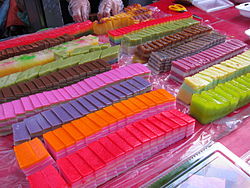
Back Kuih Spanish Kuih French Kuih ID Kuih JV 쿠이 Korean Kuih Malay Kuih Polish กูวิฮ์ Thai 粿 Chinese 粿 ZH-CLASSICAL
This article needs additional citations for verification. (February 2020) |
 Colourful kuih | |
| Alternative names | Kue (Indonesia), Kueh (Singapore, Hokkien and Teochew) |
|---|---|
| Course | Snack |
| Region or state | Southeast Asia and China |
| Associated cuisine | Brunei, China, Malaysia, Singapore, Indonesia (Kue) |
| Main ingredients | Various traditional snacks |
| Similar dishes | Mont, Khanom, Bánh, Kakanin |
| Part of a series on |
| Chinese cuisine |
|---|
 |
Kuih (Jawi: کوءيه; Indonesian: kue; derived from the Hokkien and Teochew kueh – 粿) are bite-sized snack or dessert foods commonly found in Southeast Asia and China. It is a fairly broad term which may include items that would be called cakes, cookies, dumplings, pudding, biscuits, or pastries in English and are usually made from rice or glutinous rice.[1] In China, where the term originates from, kueh or koé (粿) in the Min Nan languages (known as guǒ in Mandarin) refers to snacks which are typically made from rice but can occasionally be made from other grains such as wheat. The term kuih is widely used in Malaysia, Brunei, and Singapore, kueh is used in Singapore and Indonesia, kue is used in Indonesia only,[1] all three refer to sweet or savoury desserts.
Similar snacks are found throughout Southeast Asia, including the Burmese mont, Filipino kakanin, Thai khanom and Vietnamese bánh. For example, the colourful steamed kue lapis and the rich kuih bingka ubi are also available in Myanmar, Thailand, and Vietnam.
Kuihs are not confined to a certain meal but can be eaten throughout the day. They are an integral part of Malaysian, Indonesian, Bruneian and Singaporean festivities such as Hari Raya and Chinese New Year. Many kuih are sweet, but some are savoury.[2] In the northern states of Perlis, Kedah, Perak, and Kelantan, kuih (kuih-muih in Malay) are usually sweet. In the Southeast Peninsular states of Negeri Sembilan, Melaka and Selangor, savoury kuih can be found. Kuih are more often steamed than baked, and are thus very different in texture, flavour and appearance from Western cakes or puff pastries.
- ^ a b Claire (27 March 2020). "All About Kueh Guide". Nyonya Cooking. Retrieved 8 May 2022.
- ^ Opalyn Mok (27 March 2016). "Malaysian kuih: A marriage of flavours and cultures". The Malay Mail. Archived from the original on 4 September 2017. Retrieved 4 September 2017.